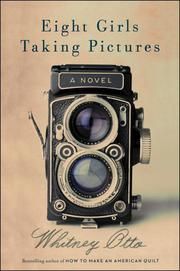I am not a photographer, although many days I wish I was. My favorite photographs, like my favorite books, are the ones that celebrate the simple details of life, altering perspective in a way that turns the mundane into art, ordinary into beauty. It is a hobby/career/calling that is rooted in passion and self-expression, just as writing is, which is perhaps why I identify with those who use their camera to say what they need to say. A camera, a notebook, a canvas- we all find a way to make our passions tangible, to make statements that reveal glimpses of what lies beneath. I start with this because I recently read Eight Girls Taking Pictures by Whitney Otto, and was paralyzed by how strongly I identified with it, as I laid in bed underlining and marking certain passages, whispering "Yes" or "Wow" at the words that seemed to echo thoughts in my own head.
 |
| Such a great title, isn't it? |
Eight Girls is dominated by a celebration of women's creative expression and passion. It also examines how each woman moved within her time period, influenced by the age in which she lived, yet stretching her boundaries further through her work and her life. Some of the protagonists fought against their circumstances, some ran from them, others used them to their advantage. They took husbands, left husbands, traveled the world, or stayed in one place. But each set out to accomplish something, to find themselves, and to express themselves in their work and art, beyond the limited expectations society allowed them. I was struck by the fact that each era seemed to demand something different from its women; the contrast between Edwardian 1915 and feminist 1970 is stark, but the limits and demands on women still existed in both, in contrasting ways- for instance, while at first it was unthinkable to imagine a life outside the home, later it was just as taboo to admit that a life inside the home could be a desired thing. This book seemed to point out that the feminist movement has been just a constant reassessment of how women can and should be defined- and it drove the point that the issue is far from settled, in society or within our own minds.
Photography acts as the common denominator between the female protagonists, and using it as a way to tell these stories was utter genius because photography is all about perspective. It is about choosing what to see, what to focus on, and how to express it. What each photographer does to capture a picture, she also does on a wider scale in determining the outcome of her life. In Eight Girls, photography represented freedom- the excuse for a girl to travel, the way in which the woman can see her lover, the view through which a mother saw her children. It is also vulnerability at its most acute, a self-portrait which none of the women can hide from. Each story starts with the photographer as apprentice, just learning an art for which she is passionate but unfamiliar; the women's ultimate mastery of photography serves to either mirror their own control over their lives, or contrast sharply with the lack of self-mastery they come to have. Through a camera, the photographer can exert control over a moment and an outcome in ways that we never can in life; in this novel, the control and freedom of making art with photographs comes to symbolize the shift in female roles throughout the twentieth century, while demonstrating that that shift is still underway.
I feel this was the first book in quite a while where I fully identified with every piece of it- each protagonist close to my age, on the cusp of womanhood, trying to determine who they are and how to direct their lives. I felt their desire to fulfill their creative passion, for that desire tugs at me incessantly day by day. But I also understood the struggle of prioritization that comes with wanting to fulfill oneself, trying to balance the tightrope that exists between what I am and what I am required to be. It is the challenge of definition. There is so much to me, to all of us, that one label or one identifier is not enough. I don't want to be defined with only one term: as mother only, as careerwoman only, as wife only. I want the entry behind my name to extend to a variety of roles, all capturing my various shades and hues like a child's kaleidoscope. But how? That is the question of Eight Girls, the ultimate game-changer, the thought that trips each woman up. And, like those women, just when I think I have it figured out, as I stand in the mirror watching myself be the woman/wife/student/careerwoman/writer/reader/cook/follower-of-passions that I want to see, the mirror shifts its focus and I must start again. It's a trick, this balancing act, a trick of perspective. Like taking a picture.
No comments:
Post a Comment
Share your thoughts!